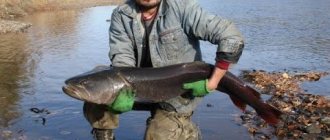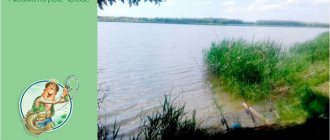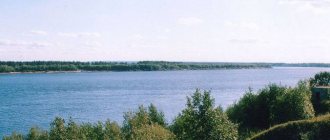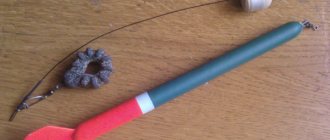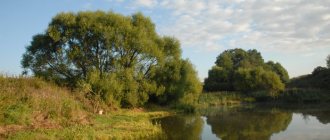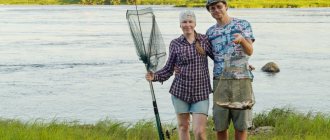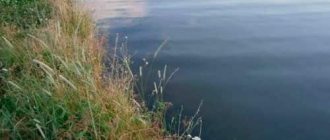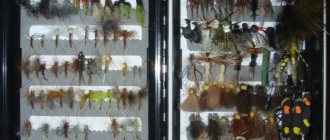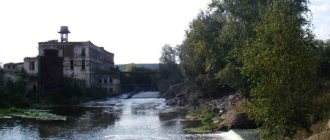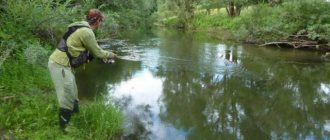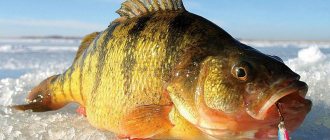Characteristic
The river is 42 km long, its sources are located near the village of Lukino. There are settlements along the river. We will tell you more about fishing here later.
Pekhorka originates from the Akulovsky water utility and flows from north to south. The river is very wide. The topography of its bottom is characterized by uniformity, and deep holes are very rare here. The river near the village of the same name is of particular interest to fishermen. Here the river first widens and then narrows, and mostly has a fast flow. You can swim in Pekhorka; its pollution does not exceed the established norm for the country.
Balashikha
As mentioned earlier, settlements are located along the river. Let's start with a story about fishing on Pekhorka in Balashikha. In this place you can fish with any gear in any quantity. Who cares? Fish in this part of the river include:
- predatory - catfish and pike, the best tackle for them is donka and spinning; There is a high chance of catching pike perch and asp using an underwater gun, spoon or jig; perch and ruffe are more willing to go to the float.
- peaceful - carp, crucian carp, roach, bream, silver bream, bleak and gudgeon are more likely to be caught using a feeder or float.
There is virtually no division into seasons here, since the river does not freeze. The only note: in winter it is almost impossible to catch carp, crucian carp and bream. As for bait, the rule applies: the more, the better. The fish is picky. It gets to the point where the bait has to be changed 10 times a day. Very important: if you want to attract fish to your fishing rod, use strong flavors, as there is plenty of natural food in the river. In a day in summer it is quite possible to catch up to 5 kg of fish.
What kind of fish is found in Balashikha
Balashikha is located in the Moscow region, so you won’t be able to find any exotic fish there. In the reservoirs of the region there are fish familiar to central Russia; most often fishermen manage to catch:
- crucian carp;
- Carp;
- Roach;
- Bream;
- Rotana;
- Pike;
- Perch;
- Pike perch.
There are no problems with large carp and crucian carp, since there are always paid ponds for those who want to fish well. But fishermen who want to catch large bream will have to work hard. The situation is the same with pike and zander.
Kraskovo
Fishing on Pekhorka in Kraskovo is no less interesting. Winter spinners should pay special attention to this area, because the conditions here are the best for them. In winter, the water level is mostly average and the water is quite clear. As mentioned earlier, you need a lot of bait. The catch will depend not only on its diversity, but also on its aroma.
Characteristics of the area: there is a current, along the shore it is quite shallow and in some places there is grass that has not yet dried out. The banks are so steep that it is difficult to approach the water. Lures: deep minnows, cranks, sinking minnows. The main task here is to overcome the current so that the bait goes in the water column, or even better, closer to the bottom and does not float to the surface.
If your target is a pike, look for it under the grass that has not yet fallen, in secluded nooks and shelters. Fishing in this place also has some unpleasant moments, as gear loss is quite likely. This happens because there is a lot of rubbish on the bottom and in the water, which the hook easily clings to.
Russian fishing
The designated fishing zone is located at the mouth of the Pekhorka River.
At this point this small river flows into the Moscow River. The place is quite crowded, since it is easy to get here by any transport, and the distance from Moscow here is insignificant. Regarding fishing, people come here to fish throughout the year. This place is popular not only in summer, but also in winter, since winter spinning has recently become increasingly popular. In this area, the Pekhorka River flows into the Moscow River. This is a small lowland river in the Moscow region, which originates in Balashikha. In its lower reaches, Pekhorka has a width of up to 40 meters. The depths here in the river reach 3-4 meters. The bottom is predominantly hard sandy, covered with a layer of silt, and there is not much aquatic vegetation. The current in Pekhorka is slow and medium. The Moscow River itself in the Spartak area is a bend in the river with a strong current and varied bottom topography. Depths in the Moscow River in this area range from 2 to 8 meters. Mostly the bottom is clean with hard sandy soil, but there are areas with shaded trees and snags. The banks are flat with little vegetation in the form of bushes and trees.
When you come fishing to this section of the Moscow River at the mouth of the Pekhorka River, you can count on catching perch, pike perch, asp, pike, roach, silver bream, bream, bleak, ruffe and others. The most popular method of fishing in these places is spinning, which can be used for fishing almost all year round. The main method used for fishing in this area is jig-spinning. Fishermen mainly use hinged baits. Both open doubles and singles, as well as offset hooks, are used as hooks. Of the baits, edible silicone baits have recently become the most popular, but foam fish have also not lost their position, especially in winter.
Spinners also often use spaced rigs. The most popular among Moscow fishermen is the retractable leash. With its help, you can catch any predator in a specified place. But the diversion works most effectively for perch and pike perch. This rig often beats the classic jig, especially when fishing in late autumn, winter and early spring.
- Location: The specified fishing area is located in the area of the settlement of Spartak near Zhukovsky
- Directions: We drive from the Moscow Ring Road along Novoryazanskoye Highway. In Ostrotsy we turn left onto Spartak
- Nozzle, bait: twister, maggot, worm
- Types of fish: Chub, silver bream, ruff, asp, rudd, tench, burbot, perch, gudgeon, roach, bream, carp, catfish, pike perch, bleak, pike, ide
Lyubertsy
Fishing on Pekhorka in Lyubertsy is very different depending on the area chosen for your favorite leisure time. So, just above Lyubertsy there is a simple small river, of which there are a huge number throughout the Moscow region. In the city itself it turns into a narrow canal. In addition, there are sewage treatment plants located here, which turn the river into a real seething stream, throwing their waste (hot) into it. Then all this seething and boiling mixture is sent to the main part of Pekhorka, and this is what prevents it from freezing. Since the water in this area is warm all year round, it is quite possible to use all summer gear here all the time, regardless of the season.
Reports, reviews
Brief reports about fishing on Pekhorka:
- 08.15 Fishing was carried out using a spinning rod. Weather: cloudy, warm, windy. Place: Pekhorka. An important point is to maintain silence, since if you frighten a duck, it is quite possible to lose a pretty pike. It took a long time to find the place. Following the “don’t scare” rule, we still managed to pull out 3 kg of fish.
- 01.15 Pekhorka (Kraskovo), Spinning, tackle: ultra light (1-8 g). Fishing was carried out against the current, at first everything was sluggish, then lively. To achieve the result I had to hide behind the bushes. I didn’t catch one impressive “representative”, then things gradually progressed. Result: about 1 kg of fish.
Reviews of fishing on Pekhorka prove its convenience in terms of using summer gear all year round, non-freezing in winter and convenient bottom topography. Some argue that the fish that live in the river with processed waste are not entirely edible. Others claim that there is nothing “that” about it, and it is quite tasty. In order to confirm or refute this fact, you need to go to Pekhorka and try to draw conclusions yourself.
From Pekhorka to Pekhorka
- Author:
Only users with a rating above 20 can see the voting results (who voted and how).
Today I went to Pekhorka for a while to open the fishing season. I have so many connections in my life with this river that this discovery should be considered symbolic.
And, indeed, if you catch the first fish of the year, then invariably on the river, which for a long time was a home reservoir, which inspired the idea of the tournament “Along Pekhorka to Pekhorka”, with the subsequent creation of the club “Seventh Roll”, where the basis was tournament regulars. So many pleasant memories come to mind when I hear “Pekhorka”.
So, off to Pekhorka for the first fish of the new year 2019!
I didn’t want to arrive too early, and it was about half past ten in the morning at the seething tank under the Bykovsky Bridge. I took my time assembling the spinning rod, tied the fly to the fence, and equipped everything with a 2 gram Cheburashka with a two-inch vibrating tail. Today my route is from the finish point of our tournament, which is near the village of Pekhorka, and downstream. It turns out, straight - From Pekhorka to Pekhorka.
And again Pekhorka
Hi all. This is me, today I won’t write much about pike fishing in the Moscow region. I am a resident of Moscow. I was born here, grew up and continue to live here to this day. Fishing here is a bit difficult compared to many other cities in Russia, so you have to try hard to catch fish everywhere. I had no problems with perch and pike perch, they are in the main water artery, the Moscow River, but I already have to chase after chub and pike. Although there is pike in almost all the rivers near Moscow, there are almost always few of them, they are pressed, stuffed, they bite carefully, and the size of the catch is not encouraging... Therefore, you always have to look for the best places. The first place near Moscow where I tried to catch pike was Pekhorka. Since those times, I really liked this place and I identified it as the main reservoir near Moscow for catching pike with wobblers. There were, of course, attempts to find new places, for example, Klyazma and Bitsa, but things there were much worse than here. In general, that’s why we decided to come here. Wake up at 05:30, breakfast, preparations, half an hour by metro, half an hour by train, then by bus, then on foot and now we are already in Pekhorka. I immediately put in a wobbler, which I have recently become very fond of, this is FishyCat Tomcat 67SP-DR. I fell in love with it even when I put it on for the first time on one of the street fishing fishing trips, and it has gotten to the point that today I put it on with the goal of catching a pike. I make the first casts and immediately notice that the level is slightly higher than winter, although not by much. From the first point I can’t catch anything, I only catch half a kilo of gravel, nothing more, we move on. Although I didn’t catch anything at the next place, at every fishing trip I felt that someone was waiting for me here. I set up a small mine, and Igor sets up the proven FishyCat Tomcat 67SP-DR. We throw, we throw, I notice that my minnoshka is not a suspender, but a sinking one, I don’t get upset much, I immediately understand why the fish were not interested in this bait... And right there, from the same place where I threw, Igor drags a pike, pulls out. Hooray! The account is open! By tradition, I photograph Igor. Photo with the first pekhorka pike.
Immediately after the photo shoot, we release the catfish into its native river. By the way, soon there will be another video from our team about this fishing... At that very moment I realized that I would stop fooling around and it was time to put a working wobbler and try to catch. The most catchy one in my box today was the same FishyCat Tomcat 67SP-DR, which, by the way, Igor caught his first pike with. I wanted to leave it at the place where I caught it in winter, but, unfortunately, it was occupied, the floater was sitting, so I had to move on. And then the roll... From the very first casts, Igor and I get caught on the same snag, but in the end I unhook, and he breaks away. But the question is, why? He had a hook with him... Well, I’ll also say that I had a way out near the stone, but I couldn’t catch it. Okay, let's move on... We cast a couple of places, but I can't catch anything there, so I move on to the place where my fisherman friend Pavel caught pike in winter. The first casts... One, two, after the third I have a way out! Again I didn't catch it. More precisely, I hooked, but didn’t catch, because during the retrieve the fence was blown onto the grass, where it got caught just before the bite, in general, I didn’t hook through the grass... I make a few more casts with different baits and understand that I scared off my fish... I approach Igor, he pulls out a perch. Again on Tomcat. At this point my nerves can’t stand it, and I put on an acidic pike Tomcat and tell myself that until I catch it with it, I won’t change it... And with this thought I walk a long distance, look around places, at the same time remembering how and where I am with my friends I caught it last year... But all the places are silent. I get up in one place that I’ve liked for a long time, the current is getting stronger here, there’s a shoal with large thickets of grass. The depth is no more than a meter, and I have a deep wobbler, I decide not to go down and fish from above, then the wobbler will move as it should, and besides, it will push off the grass with its blade. The first cast, the second... I lead, stick the blade into the grass, carefully twitch, turning the wobbler in place, the wobbler does this quite well... I make a slow reel, but still rest against the grass, I begin to reel very quickly so that the grass falls off the hooks and it falls, I slow down the wiring and feel the heaviness. A thought flashes through my head: “Fish or grass?” the Graphiteleader Bosco spinning rod is working at this moment, it’s not for nothing that I bought it... Igor starts filming, and at this time I drag the catch to the shore, Igor says in advance: “Andrey has finally caught the fish...”, but I understand that it’s too early to celebrate victory, I carefully drag the fish to the shore, go down, take it and go up. Hooray! Trophy on the shore! I finally caught what I was going for this and last time. Honestly, I'm happy. Photo…
We don’t torture the pike and immediately release it, filming the release on video... I remind you that soon our STREET HUNTERS team will edit another video about this fishing. The same Tomcat fired, I believed in him. The only competitors in my arsenal are Ever Green Ultra Sledge or Tiny Predator from the same company. In general, I am delighted with this wobbler, from that moment on it definitely became my favorite. I continue fishing in a good mood, on the same shallows, a little further downstream, I decide to try different wobblers, but this brings nothing but grass. We walk a long distance, nothing interesting happens... At this point we had to stop fishing. RESULT: Summing up the fishing, I want to say that we have fully opened the pike season. In addition, at the same time they scouted out the situation on Pekhorka, looked at what was happening, and caught it. Overall, we didn't have a bad time.
Original article here.
TOMCAT 67SP – DR
Description of the river
Its length is 42 kilometers, the basin area is 513 square meters. km. The modern source of the Pekhorka River is a man-made canal (Akulovsky water canal, Akulovsky waterworks, Eastern water canal), which was built in 1933-1937. This place is located 1.5 km north of the village of Lukino on the territory of Losiny Island. Before the construction of the hydraulic structure, the source of the river was located to the west.
Pekhorka flows from north to south. It flows through the territory of Moscow for ten kilometers in the Kuskovo and Kosino districts. It flows into the Moscow River near the city of Zhukovsky, four kilometers south of the station. railway "Bykovo". On its banks are the cities of Zheleznodorozhny and Balashikha, the villages of Kraskovo and Tomilino.
This river is shallow, but quite wide. The bottom is mostly homogeneous; holes are quite rare.
Konstantin Marin
I just returned from fishing and I immediately want to tell you how to catch bream. I caught bream for the first time, read on to find out how it happened.
Now, first things first, let's start with the fishing spot.
The fishing spot is located in the Ramensky district, the village of Spartak. Here the Pekhorka River flows into the Moscow River. We settled down not far from the confluence of the rivers. A good and popular place among fishermen, but there is also a lot of garbage around.
For fishing we will need: a spinning rod with a reel, tackle, bait, groundbait.
Tackle
We use a feeder as gear. You can assemble the feeder yourself or buy a ready-made one. This was my first time fishing with such gear. Feeders come in different designs, but basically a feeder consists of a feeder and hooks. We fill the feeder with bait and hang bait on the hooks.
Due to my lack of experience, I lost two feeders, so I had to make a feeder myself from what I had. I lost both feeders very stupidly; when casting, I forgot to open the bracket on the reel, and the feeders flew towards the other bank.
You will also need a bell or its alternative.
Bait
For bait, we took maggots, you can buy them at any fishing store or at the Bird Market (Gardener), “Zvezdochki” pasta, and semolina.
Well, everything is clear with maggots, they are already ready to eat, just put them on a hook. But the rest of the bait needs to be prepared first, when I prepare it I’ll shoot a video, but for now just the recipe:
- Asterisks
Pasta in the shape of small stars with a hole inside. Cook in water until half cooked, if overcooked they will fall apart. Rinse in cold water. To prevent the stars from sticking together, you can roll them in breadcrumbs.
- Semolina
Mix semolina with water gradually until a viscous mass is formed.
Lure
To prepare the bait you will need:
- Peas, better split into halves
- Hercules flakes, Nordic
- Semolina
Proportions, relative to the amount of peas:
- Hercules 1 – Peas 3
- Semolina 1 – Peas 1
Cook the peas for a long time until they are softened (up to several hours depending on the amount of peas). Grind the resulting mass of peas together with rolled oats using a blender, but not to a puree-like state. Gradually add semolina and bring it to a plasticine mass.
The fishing process itself is not difficult at all. We fill the feeder feeder with complementary foods and hang bait on the hooks. If there are several hooks, then you can experiment and put a different bait on each hook, in the process observing what bites. We throw the feeder approximately into the middle of the river, wait until it sinks to the bottom and close the bracket. We install the spinning rod on a stand, tighten the fishing line with a reel so that it is tight, and hang a bell on the fishing line behind the stand (there are similar electronic devices). Using the fishing line and the bell, we monitor the bite. When hooking, the bell should fly off the line; do not turn the reel while the bell is on the line, otherwise you will break the line.
Advice:
Replace the crocodile on the bells with a wine cork.
I managed to pull out 3 white breams, but I actually missed one. The best time for fishing is early morning, before dawn. From approximately 2.00 to 5.00 am, the greatest number of bites were noticed. I caught two of the three breams in the morning, and one in the afternoon.
Happy fishing!
As you understand, I am not a very experienced fisherman yet, if I presented something incorrectly, be sure to write about it in the comments.
Perhaps you have your own method of fishing, making tackle, lures or bait, tell us about your experience in the comments.
Interesting facts from history
What is so special about Pekhorka? On its banks, in the middle reaches of the river, an early Slavic culture developed - one of the most ancient not only in Balashikha, but in the entire Moscow region. There are many historical monuments here that make Balashikha the pearl of the Moscow region.
Slavic peoples have developed the Pehra basin for a long time. The first settlements of the Krivichi and Vyatichi date back to the 1st century. Finno-Ugric tribes were forced out from here to the northern regions. In the 18th and 19th centuries, the local settlements became known throughout Russia. The Golitsyn princes lived in Pehra-Yakovlevsky, the Saltykovs and Dolgorukovs - in Nikolsko-Arkhangelskoye, the Razumovsky counts in Gorenki, Field Marshal Rumyantsev-Zadunaysky - in Troitsky-Kainardzhi, where Catherine II also stayed. As a result of the development of these settlements, the Pekhorskaya volost was formed.
Historical landmarks
Today, the archaeological monuments near the village of Akatovo are of greatest historical interest. A perfectly preserved chain of mounds in a pine forest was discovered by archaeologists on the right bank of the river on the way from Kuchino to Akatovo. An ancient Slavic settlement was found not far from the mounds. This complex is one of the best preserved monuments in the entire Moscow region. On the left bank of Pekhorka, not far from Akatovo, a settlement of the 12th-14th centuries was found, which was its center at the early stage of development of the Moscow principality.
The natural landscape of these places has remained virtually unchanged since those times, and today it is one of the most beautiful corners of the Moscow region.
Pond complexes
The Pekhorka River and its tributaries form a complex of ponds, which is unique. The formation of this water system took place in stages. First, in the 15th and 16th centuries, artificial small ponds were created near small settlements. In the Nikolsko-Trubetskovo area, one of them has survived to this day. Later, in the 17th and 18th centuries, another system of man-made ponds was created, which is included in the Moscow district land survey plan of 1794. It is assumed that they appeared in connection with the construction of factories. Dams and dikes appeared in the villages of Akatovo, Pehra-Pokrovsky, Leonovo, and Balashikha. At the same time, the Malanyin pond was created, at the factory in Balashikha a pond 150 meters wide was built at the same time, a little to the south, near the village of Susanovo-Gushchinka, another one appeared, measuring 130X800 meters. This system of reservoirs on the Pekhorka River is a popular vacation spot for residents of Balashikha.
But the so-called Saltykovsky ponds are especially famous, which began to appear in the 17th century, but not on Pekhra, but on Checher, its tributary. The first ponds date back to 1651, then the owner of the village. Nikolsky were the Dolgorukovs. In the 18th century, a system of thirteen ponds, cascades, dams, and bridges had already developed. The upper ponds began to be called Tserkovnye, the one adjacent to Nikolskoe - Peasant, the largest (400X100 m) - Serebryany.
Ecology
On the bank of the Pekhorka River there is an aeration station in the city of Lyubertsev, from where waste water is discharged into the river, to be more precise, technical boiling water. Thanks to these drains, the water in the river several kilometers below the discharge never freezes in winter, even at frosts below 20 degrees. You can see billowing steam above Pekhorka, and in winter all the trees along the river are covered with frost. Lovers of photography love to come here; the pictures are truly mesmerizing.
It is not prohibited to swim in the river, as the degree of pollution is within normal limits. They say that the station's waste does not harm the reservoir and its inhabitants, which is why there are a lot of fish in it.
Fishing Features
In winter, the river does not freeze because there is an aeration station on it and hot water is discharged from it into Pekhorka.
Due to this circumstance, winter fishing is available to everyone. The feeder catches roach well in winter, but the catch is not limited to just one species.
You can catch carp, crucian carp, bream, and especially lucky fishermen come across carp.
The most fishing area, according to Pekhorsk fishing regulars, is the section of the river between its mouth and the road bridge.
Its length is small, only 2 kilometers, but fish are abundant here. Perch, chub, and bleak respond well to spinners and wobblers. The bottom holes are inhabited by pike, which bite on jig bait.
The river mouth is distinguished by species diversity. Almost all representatives of river fish, from pike to roach, are concentrated in this area.
Fishermen explain this phenomenon by the heterogeneous bottom topography and fish with different baits.
Small fish in the form of bleak or perch on a small spinner, and for large predators, for example, pike, perch, use bright wobblers or vibrating tails, which perfectly attract the attention of this fish.
The Pekhorka River carries its waters across the Moscow region for 42 kilometers.
It is shallow, the bottom relief is the same everywhere, except for the mouth, only in some areas you can find several depressions in the form of pits.
As a rule, perch and sometimes pike hide in them.
There is a lot of fish here, so Pekhorka is a favorite place for those who like a relaxing holiday.
- carp;
- gudgeon;
- crucian carp;
- roach;
- bleak;
- bream.
Less common are pike, carp, perch, and chub. There are a lot of crayfish in the waters of Pekhorka, and this is a good sign of the ecological state of the reservoir.
You can fish in any river section using all permitted gear.
Considering the nature of the river and its topography, many fishermen use spinning, fly fishing and fishing with wires.
In early spring, fishing is especially productive because the fish are actively searching for food before spawning.
Fishing
What is caught in the Pekhorka River? Fishing here is very popular among residents of Moscow and the Moscow region. According to fishing enthusiasts, crucian carp, roach, bleak, bream, bream, and gudgeon bite well. In addition, you can find perch, carp, carp, pike, and chub. There are also crayfish here.
You can fish on Pekhorka at any time of the year using permitted methods. Typically, local fishermen prefer float gear, while visitors fish with spinning rods. In winter they even fly fish and they say the catches are very good. The river bottom is homogeneous, the current is quite fast, so line fishing is considered one of the most promising types.
Local fishermen know some of the secrets of fishing in Pekhorka. As a rule, the fish don’t start biting right away, so you shouldn’t leave quickly, you just have to wait for the bite.
Experienced fishermen consider the two-kilometer section between the Ostrovtsy-Udelnaya highway highway and the mouth of the Pekhorka River to be the most successful place for fishing. Besides this, there are two more good places for fishing. One is located below the bridge downstream when the river turns left, the other is at the next left turn. In the first section there are chub, bleak, and perch. It is recommended to fish with wobblers or spinners. In the second section there is a small hole in the river bed, so it is preferable to take jig baits. Mainly pike and perch are caught here.
Downstream the spills become wider. There are good places here where chub and asp bite well. Usually caught using wobblers.
Even further downstream, the bank changes noticeably, it becomes steep, and this continues until Pehra flows into the Moscow River. 350 m from the spill downstream there is a hole where there are a lot of predatory fish that are great for jigging.
Fishing at the mouth of the Pekhorka River is different in that the bottom here is heterogeneous and almost all the fish that are here are found. You can fish with all types of bait.
The bite depends on the weather and time of year. As the fishermen themselves say, you can catch a bucket in an hour, or you can catch one or two in a whole day.
Fishing on Pekhorka
What is caught on the Pekhorka River? Fishing is very popular here. Like many rivers, Pekhorka is rich in fish species. In the waters of this river there are: Carp, Crucian carp, Carp, Roach, Chub, Asp, Bleak, Gobies, Podleschik, Bream, Catfish, Pike, Perch and possibly many more. =) Show in full. And sometimes you can even see Turtles sunbathing on pebbles or trees, warming themselves with the rays of the sun =) You can fish in Pekhorka at any time of the year in different ways. Usually, of course, amateurs prefer float gear. They can also fish with feeders, donks, and spinning rods. Sometimes you can see some abandoned nets, teles, triangles from which the fish naturally suffer.
